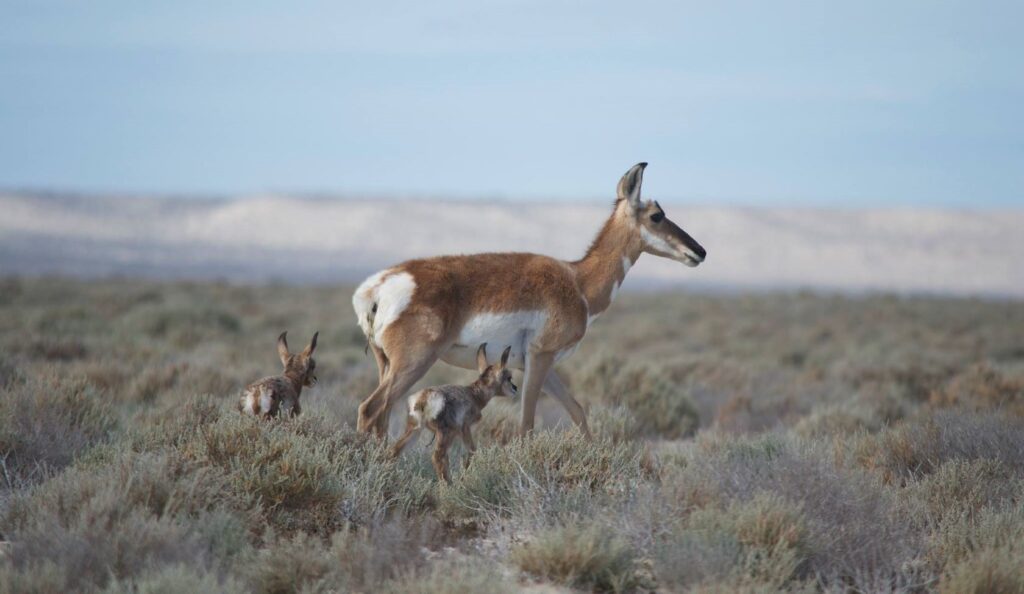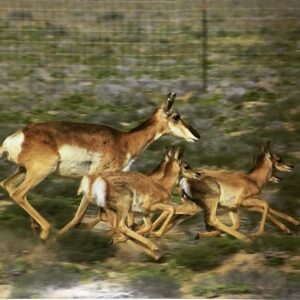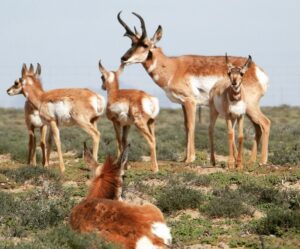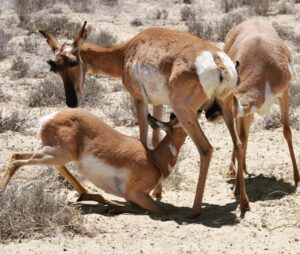To peninsular pronghorn can be found in cave paintings from the Baja California peninsula dating back more than 5,000 years; ancient records say that thousands of this species were running around in the Vizcaino Desert. Today there are less than a thousand left, but thanks to the efforts of three decades of organizations, government agencies, private companies and residents of the region, it is on its way to the end of its existence. recovery.
The peninsular pronghorn (Antilocapra americana peninsularis), endemic to the Baja California peninsula, is one of the five subspecies of the peninsular pronghorn (Antilocapra americana peninsularis). American antelopewhich is the only species of the family antilocapridae that exists in the world.
A species on the verge of extinction
According to data obtained from the Final Report from Peninsular pronghorn conservation workshopwhich dates back to 2004 and was financed by SemarnatHistorically, the population of this species was distributed from San Felipe and San Quintín, in the north of the Baja California peninsula, to Magdalena Bay in the south.
In 1925 its population was approximately 500 individuals, but during the 20th century its distribution and abundance declined to critical levels. In 1994 the population was estimated between 175 and 200 individuals distributed in 5 thousand square kilometers in the Vizcaíno Desert.
Aidée Sánchezin charge of the Peninsular Pronghorn Recovery Program in the ejido El CosteñoThe report notes that efforts to conserve this species began in the 1970s, but until the 1990s they were limited to terrestrial and aerial surveys.
"In 1993, only 164 pronghorn were seen in the core zone area of the Vizcaíno Biosphere Reserve, which alarmed the authorities and they began to make efforts to conserve the pronghorn," he explains.
A group of experts met in a workshop and from there the Peninsular Pronghorn Recovery Program. Those who formed it at that time were Semarnatthe civil association Natural Spaces and Sustainable Development (Endesu)with the financial support of Ford Motor Company that supported these efforts for 15 years.
"This financial support was what made the program really so successful and we were able to develop all the actions, from when it started in 1994 to date," he stresses.
It all started with five offspring
Once the actions were defined, Aidée Sánchez comments that in 1994, five hatchlings were captured in the Vizcaíno Desert, which were cared for by personnel who fed and stimulated them. Until 2000, they continued capturing calves at different times, until reaching a herd of 47 individuals at the Berrendo station.
Subsequently, he recalls, a second station was created in the area of La Choyaa peninsula of 26,000 hectares, surrounded by pumping canals where the Salt ExporterThe area had to be fenced off to keep the pronghorns in the area, he says.
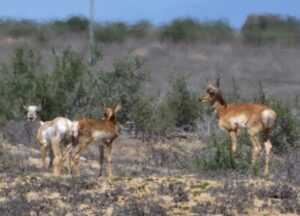
After convincing ejidatarios of El Costeño of the benefits of conserving the pronghorn, in 2011 the Llano del Berrendo stationThe owners of the plots received an annual payment for environmental services for the rental of their land for 10 years.
"In 2016 the ejido Juárez station was made, now we have three stations: La Choya, Llano del Berrendo and Benito Juárez. In these stations, the entire area that is fenced off totals 54,000 hectares that are exclusive habitat for peninsular pronghorn," he points out.
These 54,000 hectares are ejido lands for intensive management and exclusively for peninsular pronghorn, so cattle are not allowed, he clarifies.
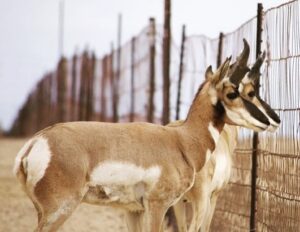
The benefits of protecting and conserving the peninsular pronghorn
In a desert ecosystem such as the one in the Vizcaino Biosphere ReserveThe peninsular pronghorn is a fundamental species for the ecological services it provides, emphasizes Aidée Sánchez.
"It is a born farmer, what it does is to cultivate its food, it cultivates its bushes, it is a ruminant that has a cloven hoof, it is in the form of a plow and when walking as a nomad, moving for very long distances, what it does is plow the desert land and breaks the hard saline layer that is made in the soil and through its excrement it deposits the seeds that it eats," he explains.
These seeds are previously scarified by its digestive enzymes and when it excretes them, it sows them in the furrows it makes with its hooves; in addition, its urine is very rich in nitrogen and carbon, so it fertilizes the desert and with the next rain the plants it eats grow again, he adds.
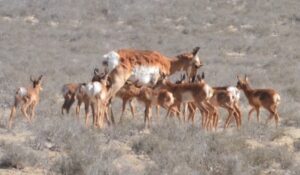
Another function they have observed the pronghorn performing is pruning invasive exotic plants, such as vidrillo, which has been taken in different programs to the region to feed livestock.
"These plants the pronghorn nibble them, tear it out of the ground and step on it with their hooves trying to destroy it, seconds after they nibble it they throw it away, so we consider it as a pruning service," he says.
In addition, he adds, the pronghorn is an umbrella species and protecting it protects birds, reptiles, the desert fox and many species that are not in danger of extinction but are threatened and benefit from this ecosystem.
It is a native species that must continue to exist.
As an endemic and native species of Baja California, the peninsular pronghorn should always remain on the peninsula, says El Costeño's PRBP manager.
"The pronghorn is threatened by anthropogenic causes, we have come to invade its space. Because they are nomadic, something that has affected them a lot is the fragmentation of their habitat. We arrive, we settle, we build our towns, our streets, our fences and all this affects the pronghorn, especially in this area of the desert where rainfall is very scarce and in certain regions, so the pronghorn wants to get to where it rained or where there is food and it runs into these barriers and cannot get there," he says.
The threats faced by the pronghorn are the coyote, which is its natural predator and is very abundant in the Vizcaíno Desert; cattle, due to competition for food; and man, not only because of the invasion and fragmentation of its habitat, but also because, despite being a protected species because it is in critical danger of extinction, it continues to suffer from poaching, he points out.
Growing population
Pronghorns are animals that can live an average of 8 to 10 years, so it is a short life span to be very productive, although females can reproduce as early as one and a half years of age.
However, little by little the efforts that have been made since 1994 to restore and save this species are bearing fruit, says Aidée Sánchez.
"Right now we have a total of around 600 pronghorn, not counting this year's calves. 600 is what we managed with last year's census, this year we have not counted the calves born from January to March, we are doing the census around July or August," he says.
He adds that 200 pronghorn were released in 2021, but an aerial census is needed every two years to find out how many individuals are in the wild and add those that are in the three seasons, he says.
"The growth in the population has been constant, we are on the right track, but the process is long, because the purpose of the program is not to have them in fences, what we want is to reinsert them, restore these populations that existed before and that the pronghorn continue in their habitat in a free way," he emphasizes.
A cause to which more people can join in
Although originally the efforts to conserve and restore the peninsular pronghorn were spearheaded by Semarnat and Endesu, with funding from Ford Motor Company, they have been joined later on by WWF, Carlos Slim Foundation, Salt Exporter y Conanp.
However, Aidée Sánchez says that there are many things that could be done, but funding is holding them back.
"In the first years we started with a few pronghorns and a lot of money, now we have many pronghorns and little money, so it is complicated to work with this because they are animals that are managed year-round and we work 24 hours a day, 7 days a week. The pronghorn have to eat all day long and it becomes very complicated to do additional actions," he says.
With the limited resources they have to prioritize the basic actions for the operation, which are the feed for the pronghorns, the maintenance of the three stations and the salaries of the workers.
"There are many actions that can still be done, they are in the census, it is in genomic study, where we are working with a doctor who is in charge of all the genetic part of the peninsular pronghorn, now we want to do a study not genetic but genomic, which will give us many answers of this subspecies and see the future predictions, if we are doing things right, if we are on the right track or what other alternatives we have to start repopulating," he says.
Therefore, he invites Mexicans to take a look at this program, to learn about the actions that are being taken and to support them as much as they can.
"If there is a businessman who wants to participate. We have been very focused on the governmental sector, but it is impossible to carry everything, so we need a lot of diffusion and we need to turn to the private sector, in the companies maybe there is someone who is interested, like Ford Motor Company that in its time, maybe someone says I can finance them in this part, because there are many actions around the pronghorn", he emphasizes.
The reward, he emphasizes, will be to save an emblematic species of the Baja California peninsula that was already running through the grasslands and desert long before man arrived.

